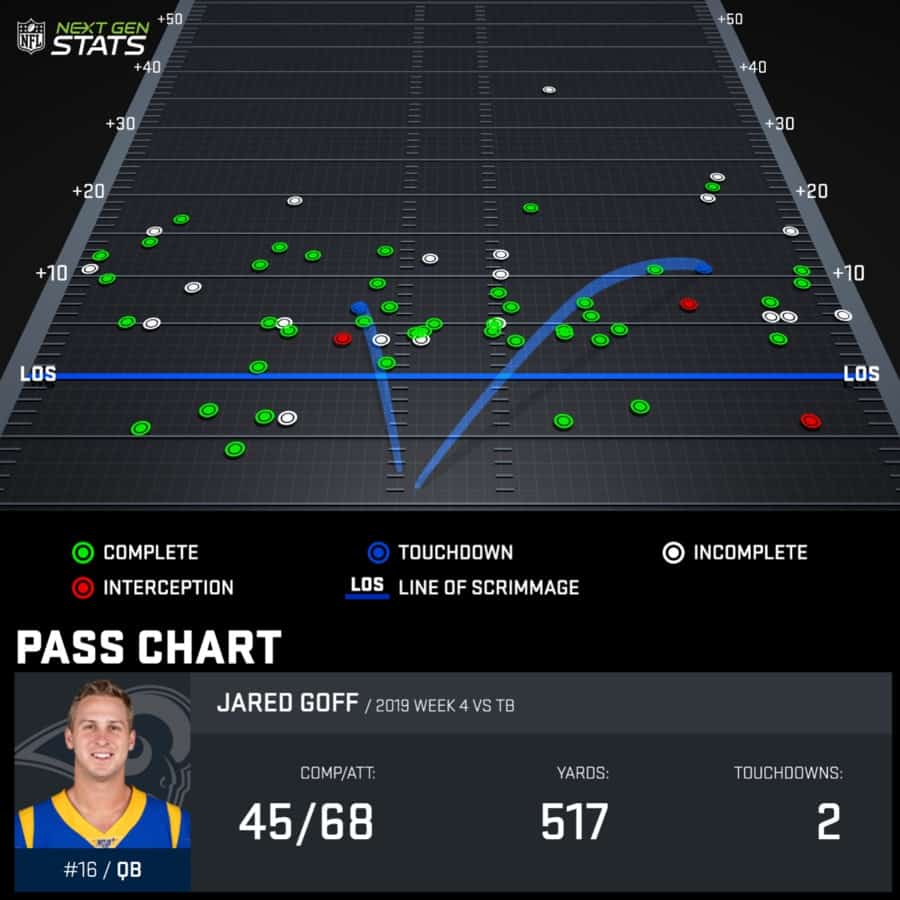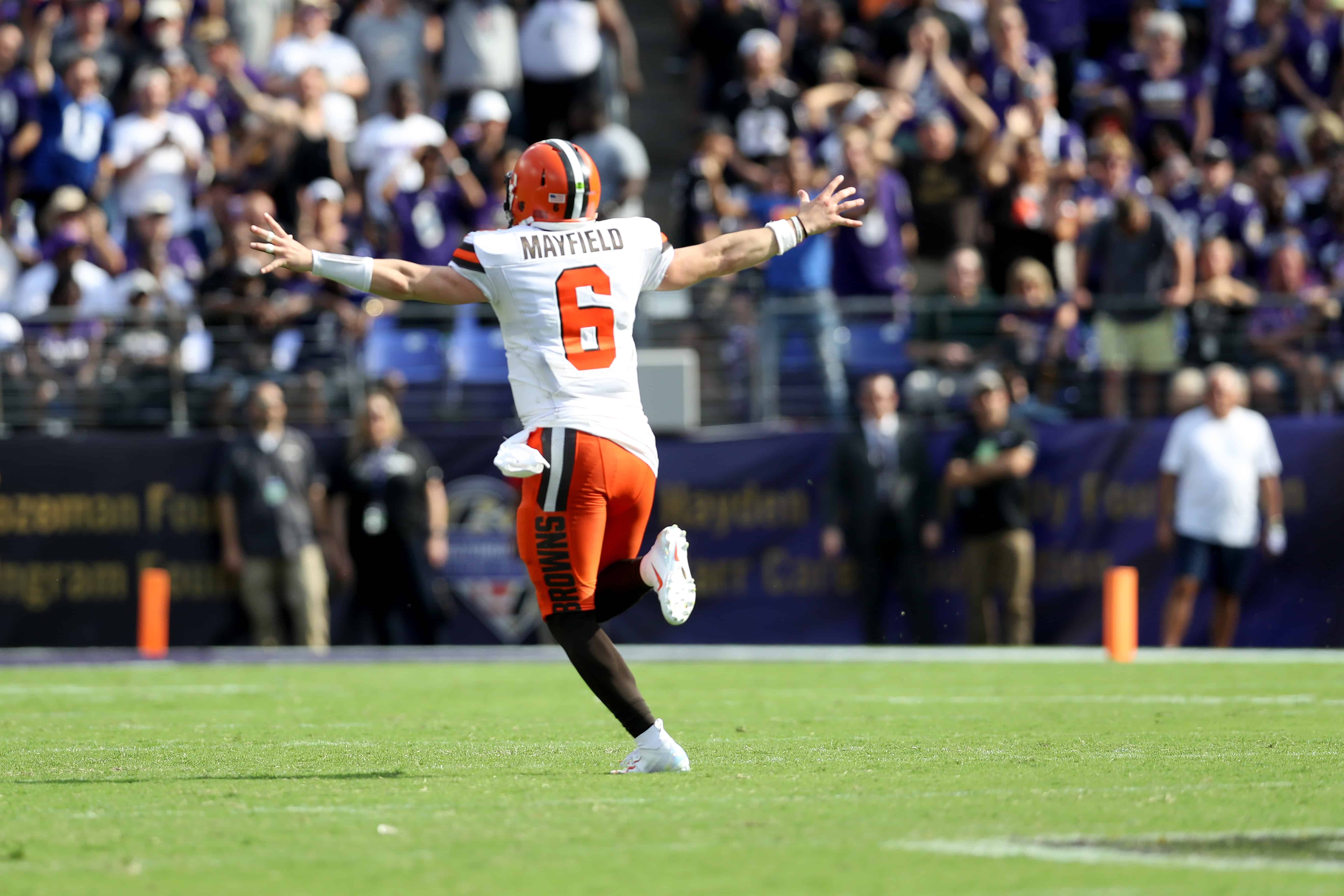It’s four weeks into the 2019 NFL regular season. We know the New England Patriots are good, the Miami Dolphins are bad, and we’re kind of figuring everything else out as we go. Let’s take a look at what we learned this week as we’re nearly a quarter of the way into the season.
1. Cleveland gets on track
It took a few weeks, but the Cleveland Browns offense found a groove in a game when it most needed to be found. The division rival Baltimore Ravens have been hit or miss on defense — they entered the week 19th in defensive DVOA, 20th against the pass and 12th against the run — and Cleveland found a way to put up 40 points en route to a victory over their biggest competition in the AFC North.
A lot of what had been ailing the Browns on offense stemmed from a disconnect on timing in the passing game. The offensive line has been brought up as a problem, but the line has done fairly well, at least early in the down. Over the first three weeks, Baker Mayfield was prone to hold onto the ball too long in an attempt to make a big play downfield. That search for the big play caused more problems than it solved and Mayfield had some of the league’s highest sack and interception rates.
That changed on Sunday when Mayfield and the Browns focused on getting the ball out quickly and trusting what the offense was creating early. Mayfield had one of the fastest time to throw averages in Week 4, a huge difference from his first three weeks. It also lowered his rate of throwing into tight windows from the past two weeks.
| Week | Avg. Time to Throw | aDOT | Tight Window % |
|---|---|---|---|
| 1 | 2.82 | 8.7 | 10.5% |
| 2 | 3.35 | 11.2 | 20% |
| 3 | 2.96 | 8.2 | 20.2% |
| 4 | 2.44 | 5.7 | 13.3% |
Jarvis Landry was the biggest beneficiary of this offensive strategy. Landry has always been his best in the short to intermediate areas of the field, but too often his ability in that area was not a positive for his team’s offense. From Miami to last year’s Browns, Landry was a high-volume, low-efficiency target. Even through three weeks of 2019, just 34% of Landry’s targets produced positive Expected Points Added. But that wasn’t the case against Baltimore. Landry led the team with eight receptions for 167 yards on 10 targets for 0.64 EPA per play and a 70% success rate.
The Browns and Landry took advantage of a defense so focused on stopping Odell Beckham, it opened up opportunities for others on the offense. Per Next Gen Stats, Baltimore cornerbacks were an average of 3.2 yards away from Beckham off the line of scrimmage. That cushion was the third-lowest for any receiver in Week 4. Meanwhile, the Ravens gave Landry plenty of cushion (an average of 8 yards) and that allowed for the open short routes with room to run.
Baltimore’s defense was so focused on Beckham, an attempt to jump a route turned into a 59-yard touchdown pass to tight end Ricky Seals-Jones.
OBJ doesn’t have a catch yet. But still impacting the game (via @NextGenStats): pic.twitter.com/NZwBHqhkc4
— Jake Trotter (@Jake_Trotter) September 29, 2019
This was a good step for a Browns offense that hadn’t fully clicked to this point or gotten into any type of rhythm. There is still room to improve with Beckham more positively involved. For now, they’ll take the head-to-head win against a divisional rival on the road.
2. Battle of the defenses
Two of the league’s best defenses met in Buffalo in an oddly important AFC divisional battle. The Buffalo Bills, at home, wanted to show they had the ability to hang with the New England Patriots. They did that thanks to a defense that kept the Patriots in check and forced Tom Brady into one of his worst career games.
Brady averaged just 3.8 yards per attempt, his fourth-lowest figure as an NFL starter. His QBR of 19.5 was his worst of the regular season in the QBR era, which dates back to 2006. Only the 2010 Divisional Game against the New York Jets with a QBR of 16.2 was worse. Brady has only had six other games with a QBR under 30.0. (Remember single-game QBR is best viewed as a win probability metric).
Buffalo coverage was tight and there were not many openings for the New England offense. Brady tried to push the ball down the field (he had an average depth of target of 8.1) but failed to connect on most of those passes. New England’s average completion came just 2.5 yards beyond the line of scrimmage, the lowest figure of the week. The Patriots had just an 18% success rate through the air and picked up a first down just 15% of pass attempts.
Unfortunately for the Bills, the Patriots defense was just as good against an offense that was worse. Last week we noted how the play of Josh Allen stopped the Bills from being able to pull away from the Bengals and that was always going to be what would keep the team from having a realistic shot against the Patriots. Three big interceptions killed Buffalo drives and never gave the offense a chance.
This isn’t all on Allen, though. This New England defense is one of the best we’ve seen. Coming into the game, the Patriots had allowed just 2.7 Adjusted Yards per attempt (weighted for touchdowns and interceptions). The next best team was the Bills at 4.5. With Week 4 included, the Patriots have allowed 1.8 AY/A. That’s the best start to the season since the 2001 Cleveland Browns had a 1.2 AY/A through four games. The 2005 Cincinnati Bengals also had 1.9 AY/A through four games, but both of those teams feasted on one big turnover day against a bad opponent and couldn’t keep the pace up through the remainder of the regular season.
New England might not have that problem. That Patriots gave up their first touchdown to an opposing offense on Sunday, a sneak at the goal line from Josh Allen. They have yet to allow a passing touchdown. Now, the defense has faced the Steelers, Jets, Dolphins, and Bills through four weeks, but the schedule doesn’t get much harder. The Patriots face Washington next week before a Thursday Night Football matchup with the Giants. This is a defense that could be setting records by the midway point of the season.
Things still look favorable for the Bills. 64% of teams that start 3-1 make the playoffs and there’s not a lot of depth in the AFC. Those three wins are banked and the Bills still have two games against the Dolphins and one more against the Jets. This defense just held an offense that had ranked fourth in DVOA to a miserable showing, but it’s clear the defense can only carry the offense so far, regardless of how good it might be.
3. The Chiefs can win tight
It’s been proven that the best way to identify a good team is by how much they can beat up bad opponents rather than how often they win close games. The Kansas City Chiefs have shown the former. In the first three weeks of the season, they weren’t really tested and handled all three opponents quite easily. Still, it helps for a team to fight through a tight game and come out with a win. That is what Kansas City had to do in Detroit, a last-minute 34-30 victory. It has to be good to know the Chiefs can win a game where Patrick Mahomes doesn’t throw a touchdown pass.
Mahomes didn’t play poorly, though. He averaged 7.5 yards per attempt and 0.27 EPA per play with a 50% success rate, per nflsrcapR. He was consistently good, but held from being great for an extended period of time. That’s a testament to the Detroit defense that didn’t have Darius Slay on Sunday. Still, the Lions have mixed scheme and players well through four weeks. Slot corner Justin Coleman has been a standout so far after a big free agent contract. He held Sammy Watkins mostly in check throughout the game.
Quickly shifting to the other side of the ball, last week we talk about how the Lions were allowing opponents to hang around due to offensive strategy. Detroit had just a 33-30 pass-run split on early downs despite a significant difference in production. The Lions averaged 0.50 EPA per attempt and a 60% success rate on early down passes but minus-0.55 EPA per play and a 33% success rate on early down rushing attempts. That near even split stopped the Lions from pulling away from any point in the game. It was a trend through the first three weeks and it didn’t hurt them, but the Chiefs proved to be too good.
4. Good? Bad? What's going on with the AFC South?
All four AFC South teams are 2-2. It's the only division where that is the case. That could appear impressive but it could be debated that none of the AFC South teams are actually any good. Let’s just do a quick run-through of the division.
Tennessee Titans: The Titans have the two most impressive wins, a Week 1 blowout of the Browns and Sunday’s 24-10 victory in Atlanta. They’re also the only team in the division with a positive point differential (plus-29). However, Tennessee is already 0-2 within the AFC South with losses to Jacksonville and Indianapolis. The Titans aren’t a team that is particularly good at anything, but they can hang around just long enough to make things interesting.
Houston Texans: Houston had an impressive come-from-behind win against the Chargers last week, but couldn’t do anything offensively against the Carolina Panthers in a 16-10 loss in Week 4. The Texans have the best quarterback in the division, but still can’t protect him; Deshaun Watson took six sacks against the Panthers. The defense has also just been average to this point. Bill O’Brien the general manager has gotten in the way of Bill O’Brien the head coach, who can only get so far without any obstacles.
Indianapolis Colts: Frank Reich is easily the best head coach in the AFC South, but this team just lost at home to the Oakland Raiders. That might automatically eliminate you from the playoffs, will have to check to official rulebook on that. Jacoby Brissett has been about as good as the Colts could have hoped, but a surprisingly effective defense from 2018 has taken a step back. Again, this team just let the Raiders put up 31 points.
Jacksonville Jaguars: This is the most fun team of the group. I mean, no other team has Gardner Minshew. Jacksonville let the quarterback air it out a little more in Week 4 (11.4 aDOT compared to 6.6 in Week 3), though it had mixed results. Jacksonville has the potential to be the most balanced team in this division, somehow, but they might also trade away Jalen Ramsey. The future of this franchise is a complete mystery.
5. Are we ever going to figure out Jameis Winston?
Jameis Winston is a quarterback with some incredibly high highs and some terribly low lows. Just this season — only four games long — Winston has put up QBRs of 89.5 and 17.3. That 89.5 figure came on Sunday in a 55-40 shootout win over the Los Angeles Rams. Winston was good for the majority of the day when the offense revolved around plays being made through the air — the Tampa run game averaged minus-0.06 EPA per play with a 30% success rate.
After a rough Week 1, Winston has bounced back and has gelled more with the offense installed by Bruce Arians. Through Week 4, Winston is 12th among quarterbacks in QBR, a year after finishing eighth. The Buccaneers are in an odd position with a decision that needs to be made on the quarterback at the end of the season with Winston on his fifth-year option.
Just a few weeks ago, it would have seemed like his on-field play was too inconsistent and his off-field troubles too much for the team to trust him long-term. But the 2019 Buccaneers are a missed field goal away from a 3-1 record in a still open NFC South.
There’s still plenty of time, but games like Sunday show why Winston was the first overall pick in 2015 but he’s just as likely to have a game that makes you wonder how that was the case.
6. Indecision in Washington
There are a number of problems with the professional football franchise in Washington D.C. We can’t get into all of them, but we can take a look at the one that played out on Sunday. Case Keenum has been Washington’s starting quarterback, as was the plan when they traded for him from the Denver Broncos. He was supposed to be the bridge quarterback while first-round pick Dwayne Haskins developed as the backup.
Despite some struggles from Keenum and the team overall through three weeks, head coach Jay Gruden was adamant there would be no quarterback change. Reports from Washington suggest Haskins was more of a front office pick than one from the coaching staff. Gruden had been vocal that Haskins is not yet ready to start in the NFL.
Then midway through the second quarter against the New York Giants, Gruden pulled Keenum and inserted Haskins at quarterback.
Keenum was not good — he was 6-of-11 for 37 yards with an interception a missed wide-open receivers for potential big plays — but it wasn’t significantly worse than what Keenum had previously shown in 2019. For Gruden to be so stern in his hesitance to start Haskins, yet still have such a quick hook for Keenum, it put everyone in a bad spot. If this was a possibility, Haskins could have spent the week getting starter reps and preparing for the game. Instead, he was thrown in trailing 14-0 and forced to make something happen. It didn’t go well — Haskins went 9-of-17 for 107 yards with three interceptions and a QBR of 26.1 — and everyone involved was put in a worse spot because of how the situation was handled.
7. Where’d you go, Kellen Moore?
Through three weeks Kellen Moore was the future. He had the Cowboys running as the model modern offense with motion, play-action, deep passes, and anything else you might want. That didn’t really show up enough in a 12-10 loss to the New Orleans Saints on Sunday Night Football.
Dallas committed to the run on early downs even though it wasn’t working. The Cowboys averaged just a 17% success rate on early down rushing attempts, though passing wasn’t much better at 21% — although the EPA per play figures greatly favored the pass.
What was most disappointing was how the Cowboys just didn’t do the same things that got them off to a hot start. Despite still going to the run and the game never getting out of control, Dallas barely used play-action — just seven drop backs, per PFF.
We’re going to have to monitor if this was just a one-game blip or if this is a trend that continues against better competition. The Cowboys face a significantly better pass defense in the Green Bay Packers next week.
8. Play of the day
There were a number of standout plays in Week 4, but the idea here is to credit design (sorry, Travis Kelce lateral). The best came from the Browns. On a 3rd and 4 on the Baltimore 31, the Browns ran a multi-option play. Cleveland came out in a trips bunch to the right that included Odell Beckham and Jarvis Landry.
Beckham motioned pre-snap and when the ball was snap, Baker Mayfield read the defense and had the option of handing off to running back Dontrell Hilliard. He pulled back and tossed a shovel pass to Landry, who was crossing behind the line. Landry then took the ball outside to the left and had the option to pitch it to Beckham for the best angle. Landry kept the ball and got down to Baltimore’s 2-yard line.
It’s a creative run play on a third and short that created multiple possibilities of being correct and converting. The Browns had the creative juices flowing all game because earlier they ran a double reverse that also involved Landry and Beckham with Beckham attempting a deep pass.
9. Chart of the day

There’s just a lot going on here. Goff had 68 passing attempts and an additional two sacks. He had 517 passing yards but most of them were while trailing. There were also three ugly interceptions involved. The first a pop-up with his arm hit. The second a forced pass to tight end Gerald Everett where he never saw the defender in front (or at least hope that was the case). Then the first was on a 4th and 2 screen so poorly set up, Goff was under pressure from a free rusher, he fired the ball where the closest player was right tackle Rob Havenstein and it was tipped for an interception behind the line of scrimmage.
10. Quarter-season awards
At the quarter pole, we can take a very quick look at how a few award races could look. Apologies to the Pittsburgh Steelers and Cincinnati Bengals who have yet to play (and the San Francisco 49ers and New York Jets on a bye) but no players from those teams were really in any consideration here anyway.
MVP: Patrick Mahomes
This was a tight decision against Dak Prescott. Both have a strong case, but at this point, Mahomes still comes out on top. Mahomes leads the league in touchdown passes and yards per attempt. Prescott has a higher touchdown rate due to fewer passes but also has three interceptions to Mahomes’s zero. There’s really no wrong answer through four weeks and this race will be one to watch for the remainder of the season.
Offensive Player of the Year: Keenan Allen
If we’re using this award as best non-QB offensive player, which some do, then it has to be Allen. He leads the league in receiving yards by 64 and has consistently been the focal point of the Chargers’ offense. He’s been able to win from all over the field while he’s had little help from teammates due to injury. He also leads the league in 20-plus-yard receiving plays with nine, two more than the next best receiver.
Defensive Player of the Year: Shaq Barrett
There’s no other place to go here. Barrett leads the league with nine sacks (Myles Garrett is second with six) and it’s not just a high sack total. Barrett also has 10 tackles for loss, two passes defenses, an interception, and two forced fumbles. He might not be able to keep this pace up for an entire season but there should be no debate on this through four games.
Offensive Rookie of the Year: Terry McLaurin
McLaurin didn’t play against the Giants in Week 4, but he led all players, not just rookies, in receiving EPA through three weeks. On a terrible Washington offense, McLaurin has been a bright spot and he’s been able to create separation at all areas of the field to get open.
Defensive Rookie of the Year: Brian Burns
This was the closest race outside of MVP. This could go to Burns or Jacksonville edge rusher, Josh Allen. Burns got the edge with a half-sack on Sunday 2.5 to 2.0 and Burns has way more quarterback hits (9 to 4), though Allen had been credited with more pressures heading into Week 4. Again, it’s hard to go wrong with either pick for this award that doesn’t mean a whole lot four weeks in.
















